
Two 29-foot aluminum Jensen launches deployed from the NOAA Ship Whiting were used to acquire multibeam bathymetric and sidescan-sonar data from the study area over an approximately 2.5-km² area during 2001 (figs. 6, 7). The bathymetric data were collected with a hull-mounted 240-kHz Reson 8101 shallow-water system aboard launch 1005. This system measures two-way sound travel time across a 150° swath, with each swath consisting of 111 individually formed 2° beams (fig. 8). The sidescan-sonar data presented in this report were acquired with a hull-mounted Klein T-5000 system operating at 455 kHz aboard launch 1014. Daily confidence checks were made of the sidescan-sonar system by observing the outer ranges of the sonar images. Original horizontal resolution of the multibeam bathymetric data was 0.5 m. However, these were also gridded to 1.5 m to eliminate data gaps. Horizontal resolution of the sidescan-sonar data is 0.5 m. Vertical resolution of the multibeam data is about 0.5 percent of the water depth.
Navigation was by differential GPS-assisted inertial navigation systems; Hypack MAX was used for acquisition line navigation. Sound-velocity corrections were derived using frequent SEACAT CTD (conductivity-temperature-depth) profiles (fig. 9). Typically, a CTD cast was conducted every 4 to 6 hours of multibeam acquisition. Tidal-zone corrections were calculated from data acquired at the Nantucket tidal gage. Vertical datum is mean lower low water.
The multibeam and sidescan-sonar data were acquired in XTF (extended Triton data format), recorded digitally through an ISIS data-acquisition system, and processed by NOAA using CARIS SIPS/HIPS (Sidescan Image Processing System / Hydrographic Image Processing System) software for quality control, to incorporate sound-velocity and tidal corrections, and to produce the continuous ASCII xyz digital terrain model and sidescan-sonar mosaic. Detailed descriptions of this processing and of the subsequent processing performed by the U.S. Geological Survey (USGS) to create the other data sets presented in this report are included in the metadata files. These files can be accessed through the Data Catalog section of this report.
The multibeam bathymetry and sidescan-sonar data were verified with high-resolution seismic-reflection data, sediment samples, and bottom photography during November 2007 aboard the Research Vessel Rafael (fig. 10). The seismic data were acquired digitally along 11 lines totaling approximately 12.6 km (fig. 11) with an Edgetech SB-512i chirp subbottom profiler (500 Hz - 12 kHz swept FM) at a 0.25-s fire rate, a 50-ms pulse length, and a 1- to 4.5-kHz sweep (swept frequency). These data were logged in the Edgetech raw seismic format (JSF) using Edgetech J-star acquisition software and converted with an in-house C program to IEEE floating point SEG-Y standard format. Surficial-sediment samples (0-2 cm below the sediment-water interface) and bottom photography were collected at 58 stations with a modified Van Veen grab sampler equipped with still- and video-camera systems (figs. 12, 13). The photographic data were used to appraise intra-station bottom variability, faunal communities, and sedimentary structures (indicative of geological and biological processes) and to observe boulder fields where samples could not be collected. A gallery of images collected as part of this project is provided in the Bottom Photography section.
In the laboratory, the sediment samples were disaggregated and wet sieved to separate the coarse and fine fractions. The fine fraction (less than 62 microns) was analyzed by Coulter Counter; the coarse fraction was analyzed by sieving; and the data were corrected for salt content. Sediment descriptions are based on the nomenclature proposed by Wentworth (1922; fig. 14), the inclusive graphics statistical method of Folk (1974), and the size classifications proposed by Shepard (1954; fig. 15). A detailed discussion of the textural laboratory methods employed is given in Poppe and others (2005). Because biogenic carbonate shells commonly form in situ, they usually are not considered to be sedimentologically representative of the depositional environment. Therefore, gravel-sized bivalve shells and other biogenic carbonate debris were ignored. The grain-size analysis data can be accessed through the Data Catalog section of this report and in the Sediment Data section. Splits of three sediment samples were collected for total organic carbon analysis. These samples were freeze dried, ground, stored in a dessicator until analysis, and analyzed on a Perkin-Elmep CHNS/O 2400 Series II analyzer.
To facilitate interpretations of the distributions of surficial sediment and sedimentary environments, these data were supplemented by compilations of sediment data from earlier studies (Poppe and others, 2003) and unpublished data sets from NOAA's National Geophysical Data Center in Boulder, Colorado. The interpretations of sea-floor features, surficial-sediment distributions, and sedimentary environments presented herein are based on data from the sediment-sampling and bottom-photography stations, on tonal changes in backscatter on the imagery, and on the bathymetry. In this paper, bedforms are defined by morphology and amplitude. Sand waves are more than 1 m high; megaripples are 0.2 to 1 m high; ripples are less than 0.2 m high. The bathymetric grids and imagery released in this report should not be used for navigation. |
Click on figures for larger images.
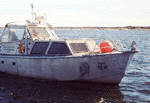 |
Figure 6. Starboard-side view of National Oceanic and Atmospheric Administration Launch 1014 afloat.
|
 |
Figure 7. Port-side view of the National Oceanic and Atmospheric Administration Ship Whiting at sea.
|
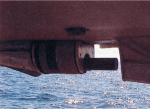 |
Figure 8. The Reson Seabat 8101 hull mounted in the keel cut out of National Oceanic and Atmospheric Administration Launch 1005.
|
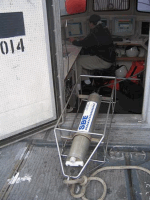 |
Figure 9. CTD (conductivity-temperature-depth) profiler.
|
 |
Figure 10. Port-side view of the USGS Research Vessel Rafael that was used to take bottom photographs and collect sediment samples in Woods Hole, Massachusetts.
|
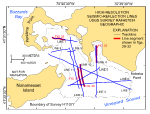 |
Figure 11. Map showing the locations of the tracklines (blue lines) along which the chirp high-resolution seismic-reflection data were collected during the November 2007 Rafael 07034 cruise and the locations of line segments shown in figures 29-32 (red segments).
|
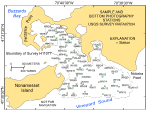 |
Figure 12. Map showing the locations of stations used to verify the acoustic data with bottom sampling and photography during the November 2007 Rafael 07034 cruise.
|
 |
Figure 13. View of the small SEABOSS, a modified Van Veen grab sampler equipped with still and video photographic systems, mounted on the aft starboard side of the research vessel Rafael.
|
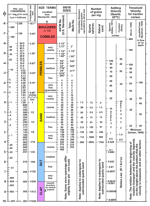 |
Figure 14. Correlation chart (Poppe and others, 2005) showing the relations among phi sizes, diameter in millimeters, size classifications (Wentworth, 1922), and American Society of Testing and Materials (ASTM) and Tyler sieve sizes.
|
 |
Figure 15. Sediment classification scheme from Shepard (1954), as modified by Schlee (1973).
|
|
